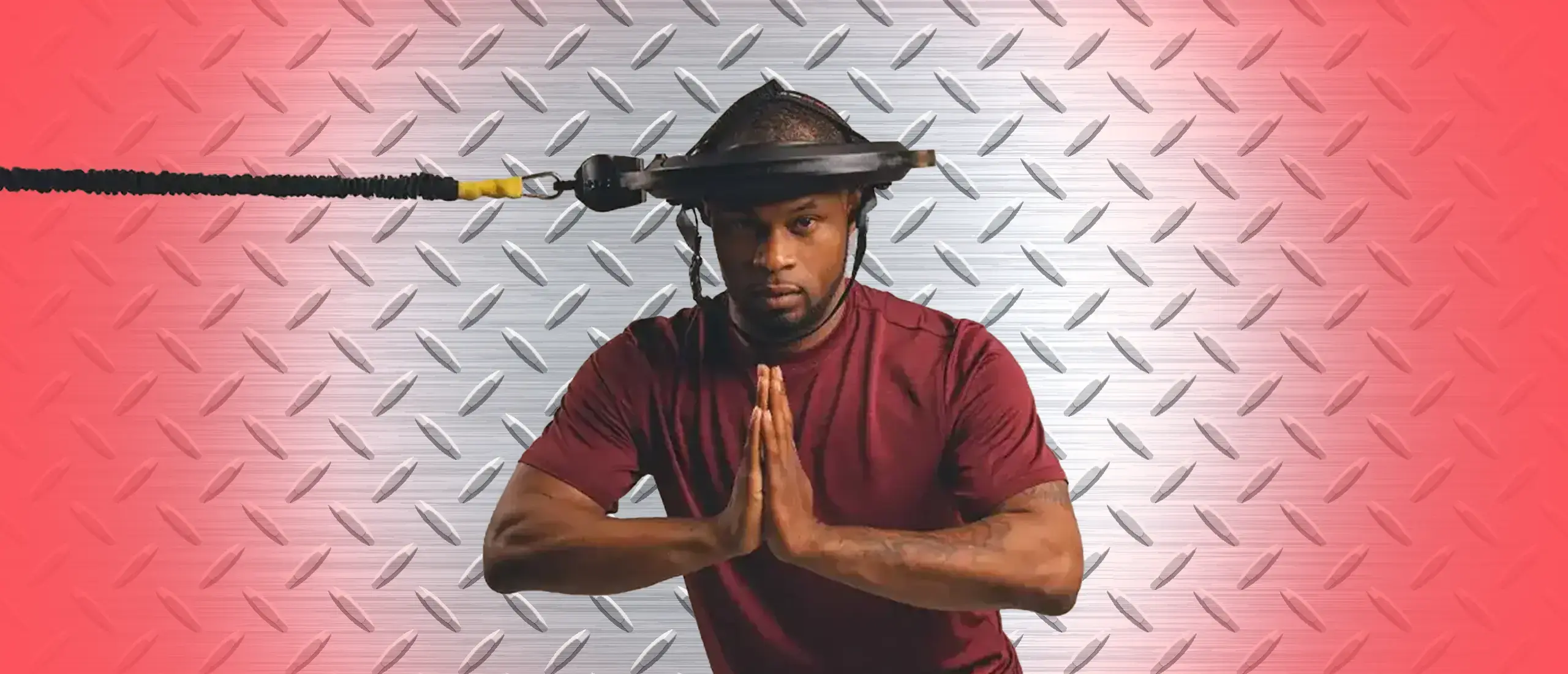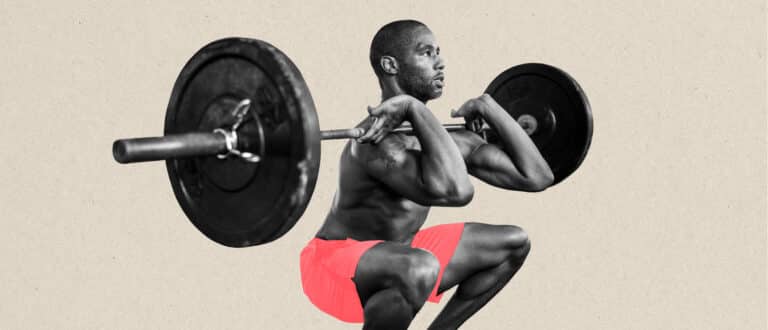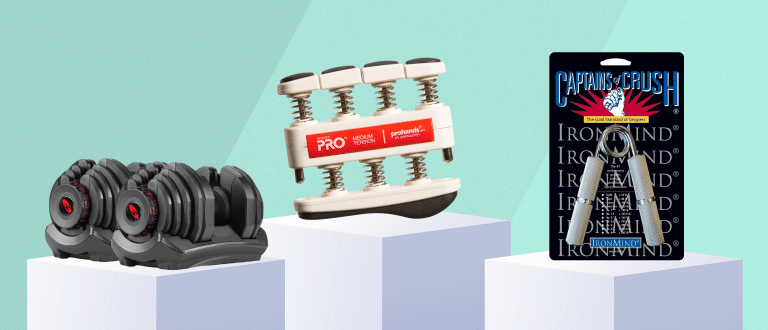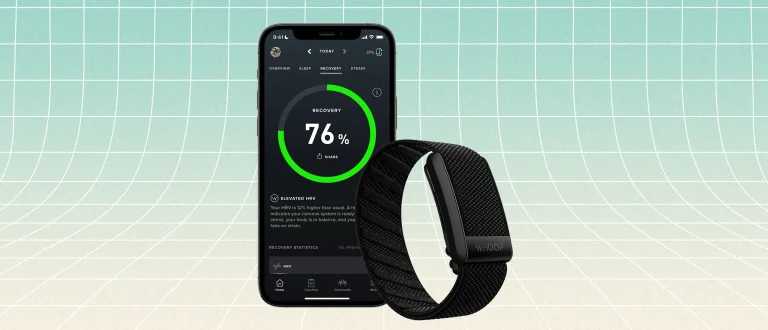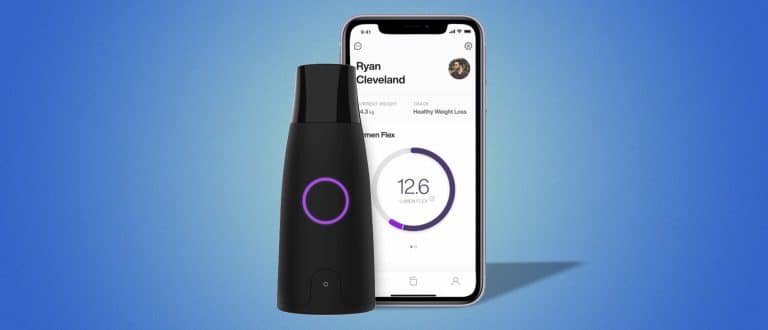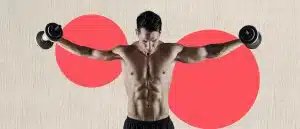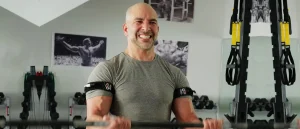The Iron Neck Single-Handedly Solved My Tension Headaches and Neck Pain
- By Sydney Bueckert, NASM C.P.T., C.E.S., F.N.S., G.P.T.S.
- November 22, 2023
Welcome to Take My Money, a column where we geek out about our favorite products.
I stumbled upon the Iron Neck like all good (and slightly sketchy) things, down a Reddit rabbit hole. Upon first glance, I thought it looked, well, ridiculous. And there’s no arguing it does. But according to athletes, physical therapists, and certified trainers, the Iron Neck is the secret to a stronger neck, a reduced risk of injury, less neck and back pain, and better posture and mobility.
While there are plenty of cheaper ways to train your neck, most of them are awkward and uncomfortable. The Iron Neck 3.0 Pro ($399) is arguably the most elegant, effective, and safe option for neck training on the market. Here’s everything you need to know.
Our Experience
Hone Health is a team of health-obsessed journalists, editors, fitness junkies, medical reviewers, and product testers. As an editor, I’ve spent years testing, researching, and reviewing fitness equipment. I’m also a certified personal trainer, and by default, I am obsessed with optimizing the way I move my body. I’ve owned a ton of fitness equipment over the years, but live in a small apartment, so I’d describe my fitness equipment arsenal as survival of the fittest. For equipment to pass my test it has to be functional, fit my body (I’ve learned the hard way spin bikes are not one-size-fits-all), and be effective.
What Is the Iron Neck?
The Iron Neck 3.0 ($349) and Iron Neck 3.0 Pro ($399) are the latest in Iron Neck’s lineup of 360-degree neck training systems designed to help target and treat muscle imbalances, prevent back and neck injuries, and improve recovery, posture, and overall mobility.
The full kit and caboodle comes with everything you’ll need, including the Iron Neck 3.0 or Iron Neck 3.0 Pro, a 25-pound resistance band, three different front pads to adjust the fit and feel of the Iron Neck, a skull cap, a door belt and anchor, a cinch anchor, and an instructional guide to help you set up and use the machine.
The adjustable headset can be clipped into any cable machine or a resistance band connected to a rack, door, or a stable post like a squat rack. Once clipped in, the Iron Neck allows for 360-degree motion, including flexion, extension, diagonal, and rotational movements. Moving through a full range of motion promotes a stronger neck, improved mobility, and the ability to quickly decelerate the head after impact (a key way to reduce concussions) (1).
These benefits have made the Iron Neck a popular tool amongst coaches and trainers of contact sports like football and Brazilian jiu-jitsu (BJJ), as well as everyday gym goers looking to improve posture and reduce the risk of injury.
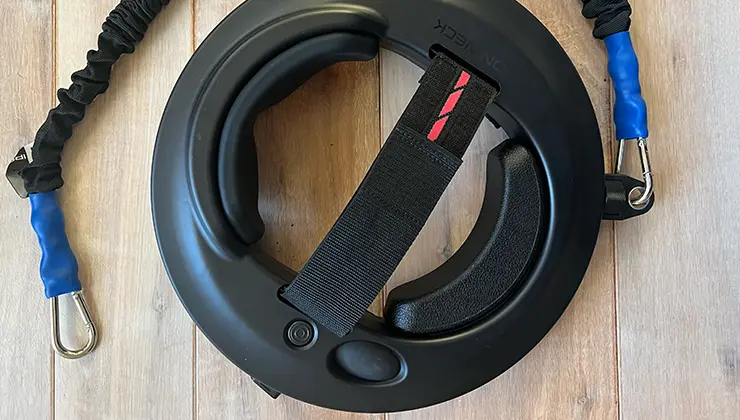
Iron Neck vs. Iron Neck Pro
Between the Iron Neck 3.0 and Iron Neck 3.0 Pro, the only difference is the friction knob. The friction knob allows you to crank up the rotational resistance, boosting strength gains. This gives the Iron Neck 3.0 Pro a decided advantage over other neck training methods like the Iron Neck 3.0, wearing a harness, or a towel-wrapped plate which only offer resistance from a fixed point. It’s also different from the four-way neck machine at the gym since the 360-degree range of motion allows you to do things like figure 8s, 360 spins, and more dynamic movements while isometrically locking your neck into place.
Why Should You Train Your Neck?
The reasons for strengthening your neck are vast, but the highlights include reducing your risk of injury (particularly concussion risk when playing contact sports), preventing neck pain, and improving posture. Plus, some guys just love the aesthetic of a thicker neck. Neck training with appropriate progressive overload (reps, sets, and load) can get you there.
What’s Good About the Iron Neck?
Superior neck training
If you’ve ever tried neck training then I don’t need to tell you that it looks and feels awkward. Once you work up to heavier loads—which isn’t uncommon with neck extension—holding a plate over your head as you teeter off the edge of a bench is finicky, to say the least. That’s where a neck harness and resistance bands, or more advanced training systems like the Iron Neck 3.0 Pro can help.
Of the lot, the Iron Neck 3.0 Pro is arguably the most comfortable and functional. Since the resistance band clips into a track that rotates around your head, you can move as you would in real life while fighting to keep your neck stable (like the locked neck body turn) or stand still to complete reps of neck protraction and retraction, side to side rotations, or more complex movement patterns like diagonals and figure 8s. I’ve found it to be a solid bet for transitioning from rehabbing my neck to prehabbing my neck to avoid future tweaks and injuries.
Since I’m, admittedly, not a contact athlete, I can’t speak to the Iron Neck’s effectiveness for those looking to prehab their neck for fights or games. However, personal trainer and BJJ athlete and coach George Briones, TSAF, who regularly uses the Iron Neck, can. “The Iron Neck is a useful tool for teaching people how to isolate their neck and move it independently to strengthen the neck muscles across all ranges of motion. This helps to improve posture and reduces the risk of neck injuries for fighters, who are more susceptible to such injuries in combat sports,” Briones explains.
Neck injury rehab and prehab
Yes, neck strength is important. But hammering muscles that are already tight with neck strengthening exercises can exacerbate pain. As a post-collegiate high jumper with a now weak but still extremely flexible neck and back, I know this fragile balance all too well. I tend to overcompensate with the backside of my body—which has plagued me with unexplained neck and back tweaks that only seem to increase in number as the years go on.
To keep your neck healthy in the long run, you’ll need to reduce mobility deficits and strengthen muscle imbalances. The good news: The Iron Neck 3.0 Pro does both. With the friction turned all the way down, you can move through a full range of motion without resistance, aiding in recovery and boosting mobility. Turning the friction up can help build neck strength; and thus, reduce injury.
Tension headaches, solved
Slouching at your desk can cause your suboccipitals—the muscles on each side of your neck at the base of your skull—to become tight and overworked. Tight suboccipitals are linked to migraines, tension headaches, and neck pain (2). I suffer from a cruel number of tension headaches on a monthly basis (it seems I have one more often than I don’t). As a regular lifter, I thought I had solid posture. Apparently, I was wrong.
Since training with the Iron Neck 3.0 Pro, I’ve noticed I have less pain in my neck throughout the day, and thus, less headaches. I can’t be entirely sure the two are linked but since the difference is night and day and it’s really the only thing I’ve changed in the past few months, I think the Iron Neck 3.0 Pro may have played a role in curing my headaches.
What’s Not So Good About the Iron Neck?
Fit issues
Not all head sizes are the same, which is why Iron Neck has gone to extensive measures to ensure the Iron Neck 3.0 Pro fits a wide scope of heads. All Iron Neck 3.0 models offer three front pads in different shapes and sizes, AirFit™ technology (which acts like a blood pressure cuff, tightening around your head with each small pump, or releasing with one big one), and an adjustable strap (like a helmet).
Between the front pads and AirFit™ technology, the Iron Neck should fit most people. I have a small head, and the biggest pad was able to get me close. With a few pumps of the air chamber, I felt locked in and ready to move. But the silly little strap gave me problems.
The straps are anchored to drop down vertically, and where that position hit me left only about the tip of my chin to hook the strap on, and left the straps about an inch away from my head on each side. I would have preferred the option to adjust the straps horizontally to get the fit snug like a helmet, but instead, the strap just hangs in my peripheral vision without providing much stability. All said, the Iron Neck 3.0 Pro still fit extremely well, and while obnoxious, the straps didn’t take away from the effectiveness of my sessions.
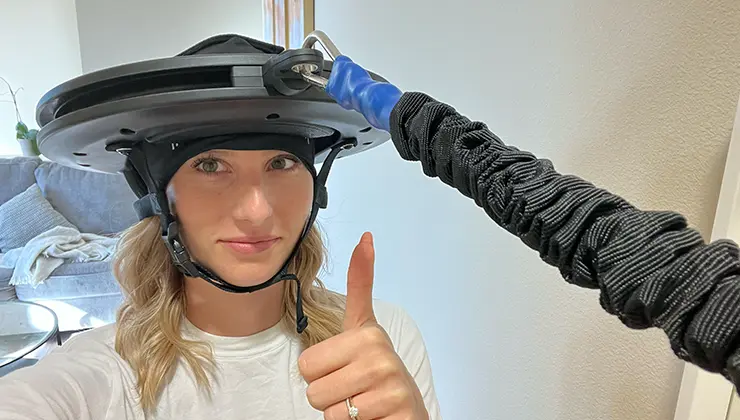
Expensive
At $599 a pop, the Iron Neck 3.0 Pro ain’t cheap. While you can easily (and more affordably) improve neck strength with a simple harness or plate setup, the Iron Neck 3.0 Pro’s 360-degree motion and friction open up your range of motion to vastly improve functional strength and mobility, and thus, injury prevention.
The Pro also offers a worthy upgrade to the brand’s cheaper model—the Iron Neck 3.0 ($349)—which offers 360-degree motion, but no rotational friction. Since the main selling point of the Iron Neck 3.0 Pro over cheaper alternatives is the rotational friction, I’d argue the Iron Neck 3.0 isn’t worth the money. If you’re going to spend on a neck training system, the Iron Neck 3.0 Pro is the way to go.
The good news: The Iron Neck 3.0 Pro goes on sale often. I bought mine off Amazon for $399. They’re similarly priced for Black Friday, and I’ve been able to find them as low as that several times throughout the past few months. My point: If you can’t swing the $599, wait it out. It will go down.
Only comes with one resistance band
The Iron Neck 3.0 Pro comes with one 25-pound resistance band. This is a crime because most people should arguably start with less resistance. Especially if you’re recovering from a neck injury. At some point, you’re also going to grow out of that band and need more resistance. For neck training to be effective, it needs to be progressive.
Sure, building up and maintaining strength with one level of resistance is better than not training your neck at all. And, you can train with one resistance band more progressively than you could a weight plate, since the resistance varies depending on how tightly the band is stretched. Still, eventually, you’ll need to cave and snag the brand’s Strength Kit (which comes with a 35- and 50-pound band) or Rehab Kit (5 and 10 pounds)—which is irksome in the least.
Looks ridiculous
If you’re looking to impress your gym crush, you might want to leave the Iron Neck at home. It will certainly turn heads—anyone who hasn’t been exposed to neck training before may think it looks insane. I personally haven’t taken it to the gym, and don’t plan to, thanks to the convenient door anchor that came with the set.
Iron Neck FAQs
You have questions about the Iron Neck, we’ve got answers.
Does the Iron Neck actually work?
Yep. Because the Iron Neck features 360 degrees of motion and tension it uniquely provides resistance through a full range of motion. This feature makes training with the Iron Neck more applicable for protecting and enhancing how you move anywhere from a football field or a BJJ mat to everyday life. The Iron Neck is particularly efficient at rehabilitating injuries in the neck and back. It’s also a good choice for athletes in contact sports like football, wrestling, or BJJ who are looking to build the strength and stability to avoid injury in the first place.
Is the Iron Neck safe?
Yes. When done correctly, using manageable loads and proper form, the Iron Neck is one of the safest ways to train your neck. The ability to load the neck without compression makes the Iron Neck safer than classic neck training techniques like neck bridges—which are effective at building neck strength, but not the best for neck health longevity-wise.
That said, proper form when using the Iron Neck is key. Just like any exercise, there are risks of neck training including but not limited to impingement, strained muscles, and nerve compression. If you have a pre-existing neck injury, talk to your doctor or physical therapist about how and when it’s safe for you to implement neck training in your rehabilitation plan. Reference the Iron Neck training guide for proper exercise form, and when in doubt work with a certified personal trainer or physical therapist.
Does the Iron Neck increase neck size?
It can. Whether you use the Iron Neck or a harness, or opt for a simple plate series, you can increase neck size by using progressive overload. In other words, hit the appropriate volume (sets and reps) and frequency (sessions per week) for muscle growth, and increase the resistance over time, and just like any exercise, you will see growth.
Since all models of the Iron Neck involve resistance bands, increasing the resistance could look like taking a step further away from your anchor point, or leveling up to a more challenging band. You could also take it to the gym and hook it into a cable machine. And if you have the Iron Neck 3.0 Pro you could also adjust the friction knob which increases the rotational tension.
What muscles does the Iron Neck work?
The Iron Neck works the muscles of your neck, head, and spine (predominantly, your suboccipitals, sternocleidomastoid, and upper trap fibers) to improve posture and strengthen your neck from virtually any angle. Since the Iron Neck Pro offers 360 degrees of motion and tension, it’s perfect for targeting the hard-to-reach intrinsic muscles of the neck that are responsible for support and stability.
The option to move through complex movement patterns while wearing the Iron Neck demands your neck muscles to functionally work together as they do in real life. This can improve stability, mobility, and strength through a full range of motion. The Iron Neck is particularly good for drills like figure 8’s or 360-degree spins, which would be tricky to accomplish with a regular plate or resistance band set up where the resistance is applied from one direction only.
The Bottom Line
The Iron Neck 3.0 Pro is expensive, but its unique 360-degree range of motion, rotational tension, and comfort fit make it well worth the money for contact athletes looking to reduce their risk of injury. It’s a solid way to increase neck mobility and strength in one hit, and the most functional and least awkward neck training option we’ve tested. If you’ve been plagued by unexplained back and neck tweaks, the Iron Neck is a great option for strengthening muscle imbalances, improving posture, and reducing pain. Still, neck and back injuries are delicate. It’s a good idea to talk to your doctor or physical therapist to see if it’s a good option for you.


